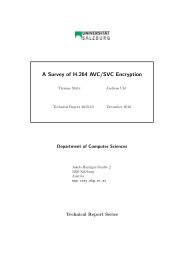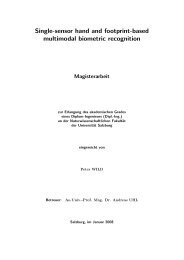Pit Pattern Classification in Colonoscopy using Wavelets - WaveLab
Pit Pattern Classification in Colonoscopy using Wavelets - WaveLab
Pit Pattern Classification in Colonoscopy using Wavelets - WaveLab
Create successful ePaper yourself
Turn your PDF publications into a flip-book with our unique Google optimized e-Paper software.
2 <strong>Wavelets</strong><br />
2.5 Pyramidal wavelet transform<br />
While the transformation process described <strong>in</strong> section 2.4 transforms a 1D-signal, <strong>in</strong> image<br />
process<strong>in</strong>g the ma<strong>in</strong> focus lies on 2D-data. To apply the wavelet transform on images first<br />
the column vectors are transformed, then the row vectors are transformed - or vice versa.<br />
This results <strong>in</strong> four subbands - an approximation subband and three detail subbands.<br />
In the pyramidal wavelet transform only the approximation subband is decomposed further.<br />
Thus, if repeat<strong>in</strong>g the decomposition step of the approximation subband aga<strong>in</strong> and aga<strong>in</strong>,<br />
the result is a pyramidal structure, no matter what image is used as <strong>in</strong>put. Figure 2.2(a)<br />
shows such a pyramidal decomposition quadtree.<br />
The motivation beh<strong>in</strong>d the pyramidal wavelet transform is the fact that <strong>in</strong> most natural images<br />
the energy is concentrated <strong>in</strong> the approximation subband. Thus by decompos<strong>in</strong>g the<br />
approximation subband aga<strong>in</strong> and aga<strong>in</strong> the highest energies are conta<strong>in</strong>ed with<strong>in</strong> very few<br />
coefficients s<strong>in</strong>ce the approximation subband gets smaller and smaller with each decomposition<br />
step. This is an important property for image compression for example.<br />
But there are also images for which this decomposition structure is not optimal. If an image<br />
for example has periodic elements the pyramidal transform is not able anymore to concentrate<br />
the energy <strong>in</strong>to one subband. A solution to this problem are wavelet packets.<br />
2.6 Wavelet packets<br />
Wavelet packets have been <strong>in</strong>troduced by Coifman, Meyer and Wickerhauser as an extension<br />
to multiresolution analysis and wavelets. In contrast to the pyramidal wavelet transform,<br />
where only the approximation subband is decomposed further the wavelet packet transform<br />
also allows further decomposition of detail subbands. This allows an isolation of other frequency<br />
subbands conta<strong>in</strong><strong>in</strong>g high energy which is not possible <strong>in</strong> the pyramidal transform.<br />
Due to the fact that any subband can now be decomposed further this results <strong>in</strong> a huge<br />
number of possible bases. But depend<strong>in</strong>g on the image data and the field of application an<br />
optimal basis has to be found. In the next sections some methods for basis selection are<br />
presented.<br />
2.6.1 Basis selection<br />
When perform<strong>in</strong>g a full wavelet packet decomposition all subbands are decomposed recursively<br />
until a maximum decomposition level is reached, no matter how much <strong>in</strong>formation is<br />
conta<strong>in</strong>ed with<strong>in</strong> each subband.<br />
The task of basis selection is used to optimize this process by select<strong>in</strong>g a subset of all possible<br />
bases which fits as well as possible for a specific task.<br />
Depend<strong>in</strong>g on whether the goal is compression of digital data or data classification for example<br />
different basis selection algorithms are used. The reason for this is that there is currently<br />
14








